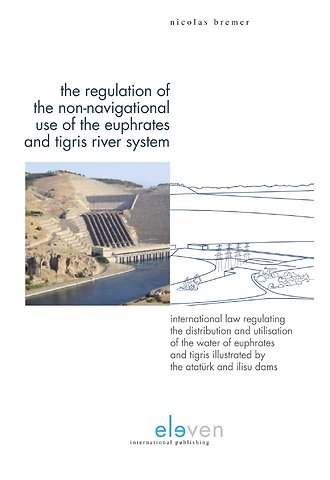The regulation of the non-navigational use of the Euphrates and Tigris River System
International law regulating the distribution and utilisation of the water of euphrates and tigris illustrated by the atatük and ilisu dams (PDF-Download)
E-book Pdf met watermerkbeveiliging Engels 2017 1e druk 9789462746817Samenvatting
This book analyses the distribution and utilisation of the water of the Euphrates and Tigris river system from the perspective of international law.
It shows which international treaties and provisions of international customary law regulating the non-navigational use of international freshwater systems are binding for the riparian states, Iraq, Syria and Turkey, and how the distribution and utilisation of the waters of the river system are governed by these. this study uses two Turkish dams - the Atatürk Dam on the Euphrates and the Ilisu Dam on the Tigris - to illustrate which provisions of international law are binding and what problems arise concerning the application of these principles.
Trefwoorden
Specificaties
Lezersrecensies
Inhoudsopgave
1 Introduction 1
A Introduction into the Conflict Matter and Posing of Problem 1
B Freshwater, Euphrates and Tigris, and Freshwater as a Subject Matter in International Law 6
I Freshwater and Its Availability and Scarcity 6
1 Freshwater 6
2 The Hydrological Cycle 7
II Hydrology, Topography and Climate in the Euphrates-Tigris River System 9
III Non-Navigational Uses of Freshwater 12
1 Non-Navigational Uses of Freshwater 14
2 Developments in Non-Navigational Uses of Freshwater 16
3 Non-Navigational Uses of Freshwater and Dams 18
IV Water Scarcity 24
1 Shortage of Freshwater Due to Secondary Effects of Population Growth 25
2 Shortage of Freshwater Due to Agricultural and Industrial Production 26
a Shortage of Freshwater Due to the Impact of Agricultural and Industrial Production on Water Quantity 26
b Shortage of Freshwater Due to the Impact of Agricultural and Industrial Production on Water Quality 28
3 Shortage of Freshwater Due to Climate Change 36
4 Conclusion 36
V Freshwater as a Subject Matter of (International) Law 37
C The Euphrates-Tigris Riparian States 38
I Political Conflicts between the Euphrates-Tigris Riparian States 39
II Availability of Freshwater and Its Use in and by the Euphrates-Tigris Riparian States 44
1 Turkey 44
a Availability of Freshwater in Turkey 45
b Freshwater Use in Turkey 46
c The Southern Anatolia Project (GAP) 46
2 Syria 50
a Availability of Freshwater in Syria 50
b Freshwater Use in Syria 51
3 Iraq 52
a Availability of Freshwater in Iraq 53
b Freshwater Use in Iraq 53
III Freshwater Related Conflicts and Negotiations in the Euphrates-Tigris River System 55
IV Conclusion 59
D Sources of International Law 60
I International Treaties 61
II International Customary Law 65
III Principles of Law 69
IV Sources of International Law outside of the Scope of Article 38 (1) ICJ Statute 70
V Subsidiary Means for the Determination of Provisions of International Law 71
E International Law Concerning Non-Navigational Uses of Freshwater 72
I International Treaties Regulating Non-Navigational Uses of Euphrates and Tigris 72
II Regulation of the Distribution and Utilisation of the Water of Euphrates and Tigris through International Customary Law 74
1 The Binding Force of International Customary Law for Non-Navigational Uses of Euphrates and Tigris 74
a Euphrates and Tigris as International Watercourses 75
b Euphrates and Tigris as International or Transboundary Rivers 78
c Definition of the Term ‘International River’ in International Law 81
2 Euphrates and Tigris as Individual Rivers or an Interconnected Hydrological System 82
a Water System Concepts 83
b The Water System of Euphrates and Tigris 87
III Regulation through Islamic International Law 90
IV Conclusion 92
2 International Law Governing the Euphrates’s Non-Navigational Use and the Atatürk Dam 95
A Dispute over the Atatürk Dam 96
B The Atatürk Dam’s Impact on the Quantity of the Euphrates’s Flow 98
I Compliance with Treaty Provisions 100
1 Compliance with the Syrian-Turkish Protocol on Economic Cooperation 100
a The Syrian-Turkish Protocol on Economic Cooperation as Legally Binding for the Distribution of the Euphrates’s Water 101
b Compliance of the Initial Impounding of the Atatürk Dam’s Reservoir with Article 6 Syrian-Turkish Protocol on Economic Cooperation Due to Its Impact on the Euphrates’s Flow 104
c Compliance of the Operation of the Atatürk Dam with Article 6 Syrian- Turkish Protocol on Economic Cooperation Due to Its Impact on the Euphrates’s Flow 107
2 The Iraqi-Syrian Communiqué on the Distribution of the Euphrates’s Water 108
3 The Paris Convention 109
4 The Angora Agreement and the Angora Convention 109
5 The Treaty of Lausanne 110
6 The Iraqi-Turkish Euphrates-Tigris Protocol 111
7 The Joint Communiqué on Cooperation between the Syrian Arab Republic and Turkey 111
8 The GAP-GOLD Joint Communiqué and Its Implementation Document 112
9 The Syrian-Turkish Memorandum of Understanding on Efficient Utilization of Water 112
10 Conclusion 112
II Compliance with International Customary Law 113
1 State Sovereignty as a Basis for International Customary Law Regarding Non-Navigational Uses of Freshwater 114
2 Absolute Territorial Sovereignty 116
a Binding Force in International Law 116
b Binding Force in the Relations between Iraq, Syria and Turkey 122
c Conclusion 125
3 Absolute Territorial Integrity 125
a Binding Force in International Law 126
b Binding Force in the Relations between Iraq, Syria and Turkey 130
c Conclusion 131
4 Community of Interest and the Concept of Optimal Utilisation 131
a Binding Force in International Law 134
b Binding Force in the Relations between Iraq, Syria and Turkey 142
c Conclusion 147
5 The Theory of Limited Territorial Sovereignty and Integrity, the Obligation
Not to Cause Significant Transboundary Harm and the Doctrine of Equitable and Reasonable Utilisation 148
a The Obligation Not to Cause Significant Transboundary Harm (No- Harm Rule) 150
b The Doctrine of Equitable and Reasonable Utilisation (Doctrine of Equitable Utilisation) 181
c The Relationship between the No-Harm Rule and the Doctrine of Equitable Utilisation 208
d Conclusion 213
6 The Theory of Intergenerational Justice, the Theory of Environmental
Accountability of State Sovereignty and the Concept of Sustainable Development 215
a The Theory of Intergenerational Justice and the Theory of Environmental Accountability of State Sovereignty 215
b The Concept of Sustainable Development 217
7 Precedence of Existing or Potential Uses of Freshwater 222
a Priority of Existing Uses or the Doctrine of Prior Appropriation 223
b Precedence of Potential Uses 226
8 Conclusion 228
III Conclusion 233
C The Atatürk Dam’s Impact on the Quality of the Euphrates’s Water 234
I Salinisation of the Euphrates 235
II Compliance of the Atatürk Dam with Treaty Provisions in Respect to
Its Impact on the Quality of the Euphrates’s Water 236
III Compliance of the Atatürk Dam with International Customary Law in Respect to Its Impact on the Quality of the Euphrates’s Water 238
1 Compliance with the Obligation Not to Cause Significant Transboundary (No-Harm Rule) 238
a Compliance of the Initial Impounding of the Atatürk Dam’s Reservoir with the No-Harm Rule 239
b Compliance of the Atatürk Dam’s Operation with the No-Harm
Rule 240
2 Compliance with the Doctrine of Equitable and Reasonable Utilisation (Doctrine of Equitable Utilisation) 243
a Compliance of the Initial Impounding of the Atatürk Dam’s Reservoir with the Doctrine of Equitable Utilisation 246
b Compliance of the Atatürk Dam’s Operation with the Doctrine of Equitable Utilisation 246
IV Conclusion 248
D The AtatürkDam’s Impact on Erosion and Transportation of Sediments by the Euphrates 248
E The Atatürk Dam’s Compliance with Obligations to Inform and Notify 249
F Conclusion 251
3 International Law Governing the Tigris’s Non-Navigational Use and the Ilisu Dam 255
A Dispute over the Ilisu Dam 255
B The Ilisu Dam’s Impact on the Tigris 258
I The Ilisu Dam’s Impact on the Quantity of the Tigris’s Flow 258
1 Compliance with Treaty Provisions 263
a Compliance with the Syrian-Turkish Memorandum of Understanding on a Pumping Station on the Tigris 264
b Compliance with the Iraqi-Syria Agreement on a Syrian Pumping Station on the Tigris 267
c Compliance with the Iraqi-Turkish Euphrates-Tigris Protocol 268
2 Compliance with International Customary Law 268
a Compliance with the Obligation Not to Cause Significant Transboundary Harm (No-Harm Rule) 268
b Compliance with the Doctrine of Equitable and Reasonable Utilisation (Doctrine of Equitable Utilisation) 279
3 Conclusion 289
II The Ilisu Dam’s Impact on the Quality of the Tigris’s Water 290
1 The Water Quality of the Tigris 290
2 Compliance with International Law 292
a Compliance with the No-Harm Rule 293
b Compliance with the Doctrine of Equitable Utilisation 298
III The Ilisu Dam’s Impact on Erosion and Transportation of Sediments
by the Tigris 302
IV Conclusion 303
C Compliance with Obligations to Inform and Consult in Respect to the Ilisu Dam 306I Information Distribution and Cooperation between Iraq, Syria and
Turkey Regarding the Ilisu Dam 306
II Compliance with General Obligations to Inform 309
1 Compliance with Treaty Provisions 309
a Compliance with the Iraqi-Turkish Euphrates-Tigris Protocol 310
b Compliance with the Syrian-Turkish Memorandum of Understanding on a Pumping Station on the Tigris 311
c Compliance with the Syrian-Turkish Memorandum of Understanding on Efficient Utilization of Water 312
d Compliance with the Memorandum of Understanding between the Turkish Ministry of Environment and Forestry and the Iraqi Ministry of Water Resources on Water 313
2 Compliance with International Customary Law – the Obligation to Exchange Information on a Regular Basis 314
a Binding Force in International Law 315
b Legal Content 317
c Binding Force between Iraq, Syria and Turkey 320
3 Conclusion 321
III Compliance with the Obligation to Prior Notification and the Obligation to Prior Consultation 322
1 Compliance with Treaty Provisions 323
a Compliance with the Iraqi-Turkish Euphrates-Tigris Protocol 323
b Compliance with the Syrian-Turkish Memorandum of Understanding on a Pumping Station on the Tigris 328
2 Compliance with International Customary Law 329
a Compliance with the Obligation to Prior Notification 330
b Compliance with the Obligation to Prior Consultation 346
3 Conclusion 363
D Compliance of the Ilisu EIAR 2001 and the Ilisu EIAR 2005 with Provisions of International Law Relating to Environmental Impact Assessment 365
I Environmental Impact Assessment under International Law 366
1 Requirement of Environmental Impact Assessment under International Law 366
2 Content of Environmental Impact Assessment 371
3 Procedure of Environmental Impact Assessment 375
a Participation of Affected States in Respect to Environmental Impact
Assessment 375
b Participation of Foreign Public in Environmental Impact Assessment 380
c Continuous Supervision of Measures Requiring an Environmental Impact Assessment 383
4 Conclusion 386
II Environmental Impact Assessment in Relations between Iraq, Syria and Iraq 387
III Binding Force in Respect to Time 390
IV Compliance of the Ilisu EIAR 2001 and the Ilisu EIAR 2005 with Provisions of International Law Regarding Environmental Impact Assessment 392
1 Consideration of the Ilisu Dam’s Transboundary Impacts in the Environmental Impact Assessment Conducted 394
2 Notification and Consultation of Iraq and Syria in Regard to the Findings of the Environmental Impact Assessment Conducted on the Ilisu Dam 398
V Conclusion 400
E Conclusion 401
4 Final Conclusion and Outlook 409
Annex – Maps 431
Bibliography 439
List of Cited Judgements, Decisions, Orders and Awards of International and National Courts and Arbitral Tribunals 469
List of Cited International Treaties, Conventions, Agreements, etc., Draft Treaties, Conventions, Agreements, Articles, etc. and Declarations 473
List of Cited Domestic Laws and Regulations 485
Anderen die dit e-book kochten, kochten ook
Rubrieken
- advisering
- algemeen management
- coaching en trainen
- communicatie en media
- economie
- financieel management
- inkoop en logistiek
- internet en social media
- it-management / ict
- juridisch
- leiderschap
- marketing
- mens en maatschappij
- non-profit
- ondernemen
- organisatiekunde
- personal finance
- personeelsmanagement
- persoonlijke effectiviteit
- projectmanagement
- psychologie
- reclame en verkoop
- strategisch management
- verandermanagement
- werk en loopbaan







